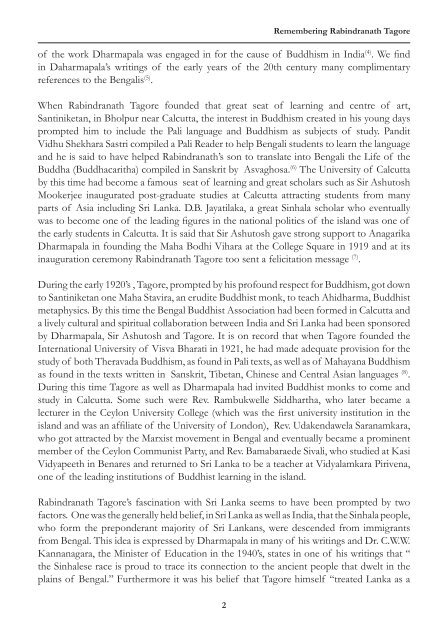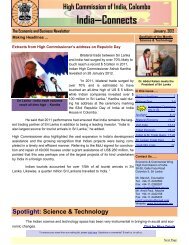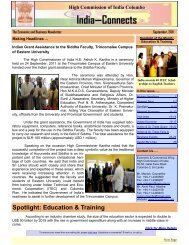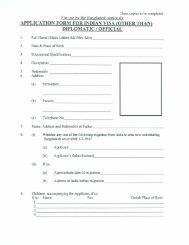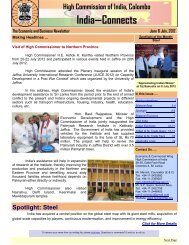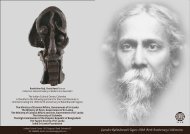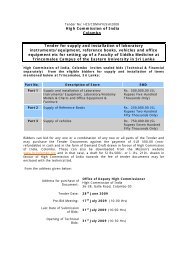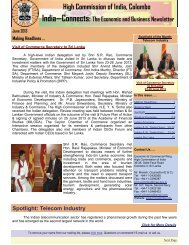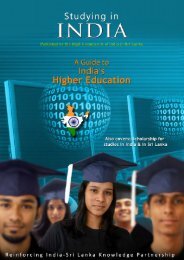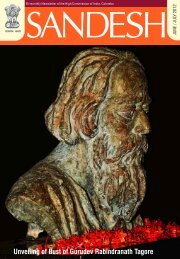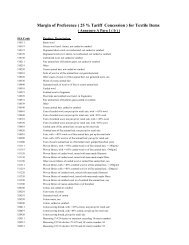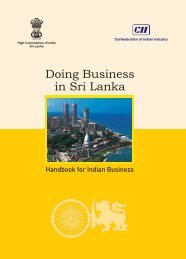Remembering Rabindranath Tagore Volume - High Commission of ...
Remembering Rabindranath Tagore Volume - High Commission of ...
Remembering Rabindranath Tagore Volume - High Commission of ...
Create successful ePaper yourself
Turn your PDF publications into a flip-book with our unique Google optimized e-Paper software.
2<br />
<strong>Remembering</strong> <strong>Rabindranath</strong> <strong>Tagore</strong><br />
<strong>of</strong> the work Dharmapala was engaged in for the cause <strong>of</strong> Buddhism in India (4) . We find<br />
in Daharmapala’s writings <strong>of</strong> the early years <strong>of</strong> the 20th century many complimentary<br />
references to the Bengalis (5) .<br />
When <strong>Rabindranath</strong> <strong>Tagore</strong> founded that great seat <strong>of</strong> learning and centre <strong>of</strong> art,<br />
Santiniketan, in Bholpur near Calcutta, the interest in Buddhism created in his young days<br />
prompted him to include the Pali language and Buddhism as subjects <strong>of</strong> study. Pandit<br />
Vidhu Shekhara Sastri compiled a Pali Reader to help Bengali students to learn the language<br />
and he is said to have helped <strong>Rabindranath</strong>’s son to translate into Bengali the Life <strong>of</strong> the<br />
Buddha (Buddhacaritha) compiled in Sanskrit by Asvaghosa. (6) The University <strong>of</strong> Calcutta<br />
by this time had become a famous seat <strong>of</strong> learning and great scholars such as Sir Ashutosh<br />
Mookerjee inaugurated post-graduate studies at Calcutta attracting students from many<br />
parts <strong>of</strong> Asia including Sri Lanka. D.B. Jayatilaka, a great Sinhala scholar who eventually<br />
was to become one <strong>of</strong> the leading figures in the national politics <strong>of</strong> the island was one <strong>of</strong><br />
the early students in Calcutta. It is said that Sir Ashutosh gave strong support to Anagarika<br />
Dharmapala in founding the Maha Bodhi Vihara at the College Square in 1919 and at its<br />
inauguration ceremony <strong>Rabindranath</strong> <strong>Tagore</strong> too sent a felicitation message (7) .<br />
During the early 1920’s , <strong>Tagore</strong>, prompted by his pr<strong>of</strong>ound respect for Buddhism, got down<br />
to Santiniketan one Maha Stavira, an erudite Buddhist monk, to teach Ahidharma, Buddhist<br />
metaphysics. By this time the Bengal Buddhist Association had been formed in Calcutta and<br />
a lively cultural and spiritual collaboration between India and Sri Lanka had been sponsored<br />
by Dharmapala, Sir Ashutosh and <strong>Tagore</strong>. It is on record that when <strong>Tagore</strong> founded the<br />
International University <strong>of</strong> Visva Bharati in 1921, he had made adequate provision for the<br />
study <strong>of</strong> both Theravada Buddhism, as found in Pali texts, as well as <strong>of</strong> Mahayana Buddhism<br />
as found in the texts written in Sanskrit, Tibetan, Chinese and Central Asian languages (8) .<br />
During this time <strong>Tagore</strong> as well as Dharmapala had invited Buddhist monks to come and<br />
study in Calcutta. Some such were Rev. Rambukwelle Siddhartha, who later became a<br />
lecturer in the Ceylon University College (which was the first university institution in the<br />
island and was an affiliate <strong>of</strong> the University <strong>of</strong> London), Rev. Udakendawela Saranamkara,<br />
who got attracted by the Marxist movement in Bengal and eventually became a prominent<br />
member <strong>of</strong> the Ceylon Communist Party, and Rev. Bamabaraede Sivali, who studied at Kasi<br />
Vidyapeeth in Benares and returned to Sri Lanka to be a teacher at Vidyalamkara Pirivena,<br />
one <strong>of</strong> the leading institutions <strong>of</strong> Buddhist learning in the island.<br />
<strong>Rabindranath</strong> <strong>Tagore</strong>’s fascination with Sri Lanka seems to have been prompted by two<br />
factors. One was the generally held belief, in Sri Lanka as well as India, that the Sinhala people,<br />
who form the preponderant majority <strong>of</strong> Sri Lankans, were descended from immigrants<br />
from Bengal. This idea is expressed by Dharmapala in many <strong>of</strong> his writings and Dr. C.W.W.<br />
Kannanagara, the Minister <strong>of</strong> Education in the 1940’s, states in one <strong>of</strong> his writings that “<br />
the Sinhalese race is proud to trace its connection to the ancient people that dwelt in the<br />
plains <strong>of</strong> Bengal.” Furthermore it was his belief that <strong>Tagore</strong> himself “treated Lanka as a


